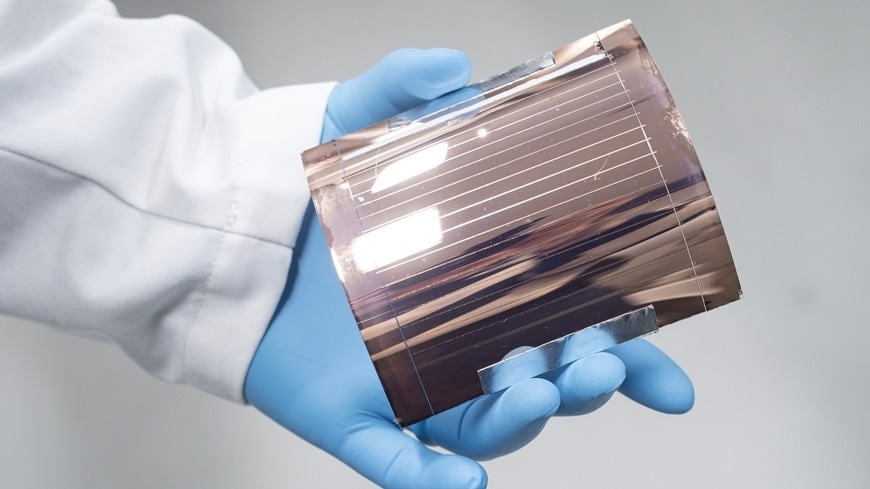All-perovskite tandem solar cells have the potential to extend beyond the limits of silicon solar cells. Empa researchers have created perovskite solar cells with a tunable band gap that can be stacked to create tandem cells with much higher efficiency.
 The two-layer perovskite solar cells can achieve higher efficiencies than silicon cells. Image Credit: Empa
The two-layer perovskite solar cells can achieve higher efficiencies than silicon cells. Image Credit: Empa
Roof tiles are rapidly becoming obsolete as an increasing number of Swiss rooftops showcase large black and blue rectangles designed to harness sunlight and convert it into electricity. The blue hue originates from silicon crystals, as most current solar cells rely on this semiconductor material. However, silicon is just one option for solar cell production – and perhaps not even the optimal one.
Silicon-based photovoltaic cells have undergone significant refinement, nearing the threshold of their efficiency potential. While there is still room for marginal enhancements, the theoretical maximum efficiency of a single silicon cell is capped at around 33%. In reality, this figure is slightly lower due to inherent energy losses during the cells' manufacturing and operation processes.
This efficiency ceiling is attributed to silicon's material properties. Its band gap dictates that only photons with specific energy levels can be converted into electricity. Photons with energy levels exceeding this threshold cannot be fully harnessed by the solar cell.
Two Layers Are Better Than One
Empa researcher Fan Fu suggests that solar cells crafted from alternative materials present a solution to surpassing this limitation. As the group leader in the Laboratory for Thin Films and Photovoltaics, Fu investigates highly efficient solar cells composed of perovskite.
While a single perovskite cell does not inherently achieve greater efficiency, as perovskite is also bound by a limited band gap as a semiconductor, the true advantage of this groundbreaking material lies in its versatility. Unlike silicon, the band gap of perovskite can be readily adjusted by altering its precise composition.
When two perovskites with different band gaps are processed into thin film solar cells and "stacked" on top of each other, the result is a so-called tandem solar cell. One perovskite layer "catches" the photons with high energy, and the other one “catches” those with low energy.
In theory, this allows efficiencies of up to 45% – much higher than the 33% of single-junction cells. Alternatively, a perovskite layer can also be added to a silicon cell to create a highly efficient tandem cell.
Fu and his team prioritize all-perovskite tandem cells, notably within the EU research initiative SuPerTandem, which engages 15 premier European research institutions and companies. The project targets the creation of flexible perovskite tandem modules achieving over 30% efficiency, employable through scalable, cost-effective production processes—an additional testament to the robustness of perovskite solar cells.
Silicon solar cells usually require high-purity silicon monocrystals that are produced at high temperatures. Perovskite thin films, on the other hand, can be printed, solution-processed, or produced by vapor deposition with a very low CO2 footprint. Small defects that occur in the process only have a minor impact on their optoelectronic properties.
Fan Fu, Researcher, Empa
Projects like SuPerTandem hold significant potential benefits, as increased efficiency directly correlates with decreased end-of-day costs for solar power.
Fan Fu adds, “The cell itself only accounts for less than 20 percent of the cost of a PV system. The remaining 80 percent is accounted for by the cables, the inverters, the junction box and, of course, the labor involved in installation.”
If the efficiency of the individual cells is increased, a smaller, more economical photovoltaic system can produce the same amount of electricity. Perovskite thin-film cells can also be manufactured on flexible, lightweight films rather than the bulky, inflexible glass plates used in silicon cells. This implies that they can be utilized in a wider range of settings, such as on automobile roofs or low-load buildings.
From the Lab to the Roof
It is now necessary to take advantage of perovskite solar cells' potential. Apart from SuPerTandem, Fan Fu's group is involved in two Swiss projects. Researchers at Empa are attempting to gain a deeper understanding of the underlying characteristics and difficulties of perovskite solar cells, which are key factors in determining their stability and efficiency, through a project supported by the Swiss National Science Foundation (SNSF).
By scaling up the tandem cells that Empa has already produced, they are putting their knowledge into practice in a project funded by the Swiss Federal Office of Energy (SFOE).
Fu states what else can be done to guarantee that the black and blue rectangles on the roofs are connected by reddish perovskite films:
“First of all, we have to scale up the perovskite cells from the current prototypes of a few centimeters to industrial sizes,” adds Fu. The cells, which are still somewhat delicate, must also be adequately shielded from the weather. Fan Fu is confident that both will be accomplished over the next five to 10 years.
We are making good progress, and there is a lot of interest from industry. Researchers have only been working on perovskite-based solar cells for just under 15 years. For comparison, research into silicon cells has been going on for almost 70 years.
Fan Fu, Researcher, Empa
Source: https://www.empa.ch